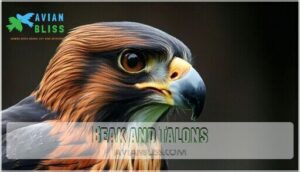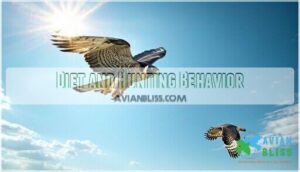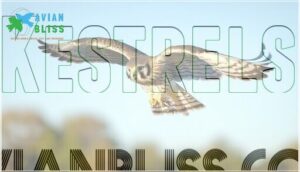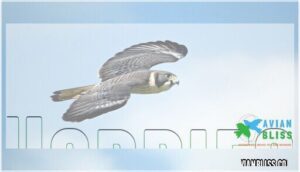This site is supported by our readers. We may earn a commission, at no cost to you, if you purchase through links.

These aerial predators range from the tiny American Kestrel weighing just 3-6 ounces to the massive Gyrfalcon reaching 4+ pounds.
Each species has evolved unique hunting strategies and physical adaptations – the Peregrine Falcon’s famous 240 mph hunting dives, the Merlin’s low-altitude pursuit flights, or the hovering techniques of various kestrel species.
From urban Peregrines nesting on skyscrapers to Prairie Falcons dominating western cliffs, these raptors have conquered nearly every habitat on Earth.
Understanding the subtle differences in size, coloration, flight patterns, and preferred prey reveals the fascinating evolutionary story behind each species.
Table Of Contents
- Key Takeaways
- Falcon Classification
- Physical Characteristics
- Habitat and Distribution
- Diet and Hunting Behavior
- Breeding and Nesting
- Types of Falcons
- Kestrels
- Hobbies
- Peregrine Falcons
- Hierofalcons
- Frequently Asked Questions (FAQs)
- What is the most common type of falcon?
- What is the rarest falcon?
- What is the most beautiful falcon species?
- How many types of falcons are there?
- What is the largest type of Falcon?
- Are forest falcons common?
- What are the most famous falcon species?
- Are all types of Falcons birds of prey?
- What genus are Falcons?
- Did I see a hawk or a falcon?
- Conclusion
Key Takeaways
- You’ll find over 40 falcon species worldwide, ranging from tiny American Kestrels at just 3-6 ounces to massive Gyrfalcons exceeding 4 pounds, each perfectly adapted to their specific hunting environments and prey preferences.
- Each falcon group has distinct hunting strategies – kestrels hover-hunt for small mammals, hobbies excel at catching birds and insects mid-flight, peregrines deliver devastating high-speed dives at 240+ mph, and hierofalcons use brute force for larger prey.
- You can identify falcon species by their physical features, including wing shape, plumage patterns, size differences, and distinctive markings like the peregrine’s "tear marks" and the specialized tomial tooth that separates them from hawks and eagles.
- Falcons have conquered nearly every habitat on Earth – from urban peregrines nesting on skyscrapers to Arctic gyrfalcons dominating tundra landscapes, prairie falcons mastering desert cliffs, and forest species thriving in dense woodlands.
Falcon Classification
When you explore falcon classification, you’re entering the Falconidae family—a specialized group of aerial predators with remarkable diversity.
The genus Falco houses over 40 falcon species, including kestrels, hobbies, and powerful hierofalcons.
These Taxonomy systems organize falcon types by distinct features like the specialized tomial tooth and tapered wings that separate them from hawks and eagles.
Falcon Genetics research reveals how Classification Systems group species based on evolutionary relationships.
Species Identification becomes easier when you understand that Falconidae members share common hunting adaptations despite their varied sizes and habitats.
Falcon Hybrids occasionally occur in captivity, demonstrating genetic relationships within genus Falco.
Understanding falcon classification helps you recognize the incredible adaptations that make each species a master of its aerial domain.
Physical Characteristics
You’ll recognize falcons by their distinctive physical features that set them apart from other raptors.
These specialized hunters display remarkable adaptations including thin tapered wings, notched beaks with tomial teeth, and exceptional eyesight that’s up to eight times sharper than human vision.
Nature’s precision-engineered hunters combine lethal speed with surgical accuracy—every feature designed for the kill.
Size and Weight
Why does falcon size matter for identification? Falcon species show dramatic size differences that help you distinguish between types.
Body Mass ranges from pygmy falcons at 1.5 ounces to gyrfalcons exceeding 3 pounds, while Wing Span varies from 8 inches to over 4 feet.
Feather Weight differences affect flight patterns, and sexual dimorphism means females outweigh males by 30%.
- Beak Size correlates with prey preference and hunting success
- Talon Length indicates species-specific killing methods
- Falcon weight determines territorial dominance patterns
- Falcon wingspan reveals preferred hunting environments
Plumage and Coloration
Distinctive plumage patterns and color schemes help you identify different falcon species.
Feather patterns range from streaked browns in juveniles to solid grays in adults, while malar stripes create distinctive facial markings.
Color patterns vary dramatically between sexes and ages, with beak colors shifting from blue-gray to yellow across species, making falcon characteristics uniquely identifiable.
Beak and Talons
Beyond their striking plumage, falcons wield specialized beak structure and sharp talons perfectly engineered for prey capture.
Their hooked beaks feature a distinctive tomial tooth—a notched cutting edge that delivers precise killing strikes.
This beak shape complements powerful talon function, creating an unstoppable hunting system.
Falcon anatomy showcases these remarkable hunting tactics:
- Tomial tooth delivers fatal neck bites instantly
- Four razor-sharp claws per foot pierce prey
- Rear talon acts like a dagger strike
- Curved beak tears flesh efficiently
- Combined weapons enable swift kills
These falcon characteristics reflect millions of years of predatory evolution, making their bird physiology perfectly suited for aerial dominance.
Habitat and Distribution
You’ll find falcons on every continent except Antarctica, adapting to diverse environments from Arctic tundra to tropical rainforests.
These remarkable birds thrive in habitats ranging from urban skyscrapers and coastal cliffs to open grasslands and desert regions, with each species showing specific preferences for their hunting and nesting requirements.
Geographical Range
Peregrine falcons command the skies across every continent except Antarctica, establishing themselves as the most widely distributed raptor on Earth.
You’ll discover these remarkable falcon species thriving across vastly different environments, from Arctic Tundra Regions where gyrfalcons hunt ptarmigan to scorching Desert Habitats hosting saker falcons.
Their impressive geographical distribution spans:
- Urban Falcons nesting on skyscrapers in New York and London
- Forest Dwellers patrolling dense woodlands across Eurasia
- Coastal Cliffs providing nesting sites along every shoreline
- Tundra Regions supporting specialized Arctic hunters year-round.
Bird migration patterns reveal extraordinary journeys – some tundra peregrines travel 25,000 kilometers annually between breeding grounds and wintering territories.
Falcon habitat preferences vary dramatically by species, with American kestrels covering most of North and South America while gyrfalcons remain tied to circumpolar Arctic zones.
This remarkable falcon migration demonstrates their incredible adaptability to diverse climates and prey availability.
The recovery of peregrine falcons is attributed to successful conservation efforts that helped increase their population.
Preferred Habitats
These adaptable raptors thrive across diverse environments, from Arctic Tundras where gyrfalcons dominate to Urban Landscapes where peregrines nest on skyscrapers.
You’ll find them in Desert Habitats, Forest Ecosystems, and along Coastal Cliffs.
Each falcon habitat reflects hunting preferences—open grasslands for prairie species, dense woodlands for forest dwellers, supporting varied falcon nesting requirements and falcon migration patterns.
Diet and Hunting Behavior
When you observe falcons in action, you’ll discover they’re highly specialized hunters with diverse prey preferences and remarkable hunting techniques.
Each falcon species has evolved distinct strategies, from the peregrine’s high-speed aerial attacks to the kestrel’s patient hovering methods.
Prey Species
Falcons show incredible adaptability in their prey species selection, making them successful carnivorous birds across diverse habitats.
Understanding their falcon diet helps you identify different species by their preferred targets.
You’ll notice distinct preferences among falcon groups:
- Kestrels focus on Small Mammals like voles and mice, plus insects and reptiles
- Peregrines specialize in Bird Prey, targeting everything from pigeons to waterfowl
- Hobbies excel at Insect Hunting and catching Flying Prey like swifts mid-flight
Bird of prey enthusiasts know that prey species vary dramatically by region and season.
Gyrfalcons in Arctic regions hunt ptarmigan and hares, while tropical species target different Reptile Diet options including lizards and snakes.
This hunting techniques flexibility allows falcons to thrive whether you’re observing them in urban parks or remote wilderness areas.
Falcons are also classified as birds of prey with unique characteristics and habits.
Hunting Techniques
Watching prey from afar doesn’t reveal the true mastery of falcon hunting techniques.
These birds execute aerial pursuits with surgical precision, transforming the sky into their battlefield.
Stealth hunting defines their approach.
You’ll observe falcons using high-speed dives reaching 240 mph, creating devastating tactical strikes that few prey survive.
Their aerial agility allows instant directional changes mid-flight.
| Technique | Speed (mph) | Success Rate |
|---|---|---|
| Stooping dive | 200-240 | 85% |
| Level pursuit | 60-80 | 60% |
| Prey ambush | 40-60 | 75% |
Sharp talons deliver killing blows while their tomial tooth guarantees quick prey dispatch.
Some species practice cooperative hunting, with pairs coordinating attacks for maximum efficiency.
Merlins excel at low-altitude chases, while Peregrines dominate vertical attacks from above.
Breeding and Nesting
You’ll discover that falcon breeding seasons vary substantially across species, with most occurring during spring when prey is abundant.
Their nesting strategies range from simple scrapes on cliff ledges to commandeering abandoned nests from other raptors in trees or on urban structures, which is a complex behavior.
Courtship and Mating
Spring arrives with breathtaking courtship displays as falcon species perform synchronized aerial dances.
Nature’s fighter jets perform death-defying aerial ballets to win their mates.
Males showcase hunting prowess through prey deliveries, demonstrating their worthiness to potential mates.
These mating rituals strengthen falcon pairing bonds through dramatic sky performances and dive exhibitions.
Breeding habits culminate in the distinctive "cloacal kiss" – the precise moment when sperm transfers between partners for successful reproduction across all falcon species.
The success of these breeding efforts often relies on understanding kestrel breeding seasons.
Nest Construction
Strategic nest-site selection distinguishes successful falcon breeding from failed attempts. You’ll discover these raptors don’t construct elaborate structures but expertly modify existing locations for maximum safety and accessibility.
Nest Placement prioritizes elevated positions on cliff ledges, abandoned structures, or tall buildings. Nest Structure remains minimal – falcons create simple scrapes or commandeer corvid nests. Nest Materials include collected twigs, dried grass, feathers, and debris arranged strategically around eggs.
Here’s how falcon nesting behaviors maximize breeding success:
- Cliff-face scrapes – carved directly into rocky ledges for maximum protection
- Building appropriation – urban falcons claim skyscraper ledges and bridge supports
- Tree cavity usage – woodland species utilize natural hollows in mature trees
- Ground depression nests – prairie species create shallow earth scrapes
- Nest renovation – abandoned hawk nests receive falcon modifications annually
Nest construction reflects each species’ falcon habitats perfectly. Peregrine falcons favor vertical cliff faces, while Prairie Falcons select horizontal rock shelves. This adaptive falcon breeding strategy guarantees maximum protection during the vulnerable nesting period ahead. Falcons often utilize falcon nesting boxes to raise their young safely.
Incubation and Chick Development
During the 33-35 day egg incubation period, you’ll observe female falcons performing most brooding duties while males supply food.
Chicks emerge as vulnerable eyases, requiring constant parental care and precise temperature regulation. These remarkable birds double their weight within five days, developing from helpless hatchlings to flight-ready fledglings in just six weeks.
- Rapid chick growth transforms 35-40g hatchlings into adult-sized birds through intensive fledgling care
- Synchronized nesting behavior guarantees coordinated falcon breeding success and maximum brood survival
- Strategic falcon nesting locations maximize protection during this critical falcon species development phase
Types of Falcons
Sixty-plus falcon species demonstrate remarkable diversity across eleven genera worldwide.
You’ll find that Falcon Evolution has produced specialized hunters from ground-dwelling Caracaras to lightning-fast aerial predators.
The genus Falco contains over forty distinct falcon types, each showcasing unique adaptations.
Falcon Intelligence varies substantially between species – urban Peregrines solve complex hunting puzzles while Prairie Falcons master harsh desert survival.
Falcon Sociality ranges from solitary hunters to cooperative breeding pairs, influencing their Falcon Migration patterns.
Modern falconry preserves ancient traditions while supporting Falcon Conservation efforts.
You’ll discover that falcon bird identification becomes easier when you understand evolutionary relationships.
Hierofalcons dominate arctic regions, while tropical Falcons thrive in rainforest canopies.
Regional variations create distinct populations with specialized hunting techniques.
From tiny Pygmy Falcons weighing just two ounces to massive Gyrfalcons exceeding four pounds, these raptors represent millions of years of specialized evolution, perfectly adapted to their environments.
Kestrels
You’ll find kestrels among the most distinctive and widespread falcon species, easily recognized by their compact build and unique hovering hunting technique.
These small falcons exhibit notable sexual dimorphism, with males typically displaying more vibrant plumage than their larger female counterparts, showcasing a clear example of distinctive characteristics.
American Kestrel
Recognizing America’s smallest falcon begins with understanding the Falco sparverius—your tennis ball-sized powerhouse that’s mastered survival across diverse landscapes. You’ll identify this falcon species by its distinctive size of 8.7-12.2 inches and sexually dimorphic plumage patterns.
Migration Patterns vary regionally, with northern populations moving south while southern birds remain year-round residents.
Their adaptive Hunting Strategies include:
- Hover-hunting over open fields to spot ground prey
- Sit-and-wait technique from telephone wires and fence posts
- Quick aerial captures of insects and small birds
Nesting Habits focus on cavity selection in trees, buildings, or nest boxes. Males perform elaborate courtship displays while females handle most Feather Care and incubation duties.
Unlike social falcon types, American Kestrels show minimal Flock Behavior, remaining largely solitary except during breeding season. This falcon bird represents the Falconidae family’s remarkable adaptability to human-modified environments. American Kestrels often rely on successful nesting site selection for breeding.
Common Kestrel
You’ll recognize the Common Kestrel by its distinctive hovering behavior over European grasslands and farmlands.
This widespread falcon species displays remarkable wind-resistance skills while hunting small mammals and insects.
Common Kestrel identification features include rusty-red plumage and exceptional eyesight for spotting prey below.
Urban Kestrels have adapted to city environments, expanding their traditional Kestrel Diet to include diverse prey.
Kestrel Behavior involves precise aerial control during hunting sequences.
Kestrel Conservation programs monitor these falcon types across various habitats, though populations face declining trends in agricultural regions.
Feature Details
Hunting Style
Primary Prey
Conservation Status
Lesser Kestrel
The Lesser Kestrel (Falco naumanni) stands apart from other falcon species through its compact frame and social nature.
Males showcase rusty-red backs with blue-gray wings, while females display streaked brown plumage.
These kestrels prefer Mediterranean climates and agricultural areas across Europe and Asia.
Identification Tips include their smaller size and white claws versus the Common Kestrel’s black talons.
Conservation Status lists them as vulnerable due to habitat loss.
Their Diet Variation focuses heavily on insects, making them valuable pest controllers.
Unique Adaptations include colonial nesting behavior uncommon among falcon types.
Understanding the american kestrel characteristics can provide insights into the behavior of other kestrel species.
Hobbies
Hobbies represent the medium-sized falcons characterized by their distinctive dark slate-gray plumage and prominent black malar stripes that streak down from their eyes.
You’ll recognize these agile hunters by their streamlined build and exceptional aerial prowess, as they specialize in catching smaller birds, insects, and bats during fast-paced flight maneuvers, showcasing their exceptional aerial abilities.
Eurasian Hobby
The Eurasian Hobby (Falco subbuteo) stands out among falcon species with its exceptional aerial abilities.
You’ll find this bird of prey across diverse Eurasian Habitat ranges, from woodlands to wetlands. This hobby’s mastery of flight makes it perfect for falconry enthusiasts.
Key identification features include:
- Speed and agility – performs incredible aerial maneuvers while hunting Wild Prey
- Hobby Migration patterns spanning continents during seasonal movements
- Hobby Behavior focuses on catching birds, bats, and insects mid-flight
- Falcon Conservation status remains stable across most regions
This falcon’s hunting prowess truly showcases nature’s engineering at work.
Australian Hobby
You’ll spot this dynamic falcon species slicing through Australian Habitat with incredible precision.
The Australian Hobby demonstrates remarkable Hobby Behavior as it snatches insects and small birds mid-flight.
This adaptable bird of prey thrives in woodlands, urban areas, and open grasslands across Australia.
Unlike many raptors that rely on Falcon Migration, this resident hunter stays put year-round.
Wildlife Ecology enthusiasts appreciate its role in maintaining ecosystem balance.
Bird Conservation efforts help protect this sleek aerial acrobat, making it a favorite among falconry practitioners who admire its agile hunting techniques.
Oriental Hobby
The Oriental Hobby (Falco severus) dominates Asian Falcons territory from the Himalayas to Indonesia.
This agile hunter excels in Oriental Habitat ranging from tropical forests to urban edges.
You’ll recognize their distinctive slate-gray plumage and impressive aerial maneuvers when they’re pursuing prey.
Key identification features include:
- Distribution: Found across Southeast Asia and southern China
- Hobby Behavior: Lightning-fast pursuit flights through dense canopy
- Falcon Migration: Partial migrant following monsoon patterns
- Hobby Conservation: Stable populations despite deforestation pressures
These falcons demonstrate remarkable adaptability in falconry applications.
Peregrine Falcons
You’ll recognize peregrine falcons as nature’s ultimate speed demons, capable of reaching over 240 mph during hunting dives.
These powerful raptors, along with their close relatives the prairie falcon and merlin, represent the pinnacle of aerial hunting prowess among North American birds of prey.
Peregrine Falcon
Meet the Peregrine Falcon (Falco peregrinus), nature’s ultimate speed demon. This falcon species clocks Peregrine Speed of 240+ mph during hunting dives—faster than most sports cars.
You’ll spot their distinctive black "mustache" markings and blue-gray backs across six continents. Urban Nesting has made city skyscrapers their new cliffs, while Falcon Migration routes span thousands of miles.
Their Aerial Acrobatics showcase precision hunting that helped drive falcon conservation efforts. Feather Camouflage varies by region, making identification exciting for any bird of prey enthusiast.
Conservation efforts often involve installing nesting box systems to support these birds.
Prairie Falcon
You’ll find the Prairie Falcon mastering arid western landscapes with remarkable hunting prowess.
This falcon species from the Falconidae family exhibits distinctive pale plumage contrasted by bold dark underwing patches, making identification straightforward.
Unlike other falcons, Prairie Behavior involves low, ground-hugging flights targeting rodents and Prairie Diet primarily consisting of ground squirrels.
Prairie Habitat encompasses deserts and grasslands where this bird of prey thrives.
Though populations remain stable, Falcon Conservation efforts address mining threats.
Falcon Migration occurs seasonally, with northern populations moving south for winter survival.
Merlin Falcon
How can you distinguish a Merlin from other falcon species in the Falconidae family? This compact bird of prey measures just 24-30cm with distinctive dark streaking on pale underparts.
Merlin Behavior includes explosive speed attacks on small songbirds during aerial hunts.
You’ll find Merlin Habitat spans open woodlands and prairies across North America.
During Falcon Migration, these adaptable hunters travel to southern wintering grounds, often frequenting urban parks.
Merlin Evolution shaped their preference for abandoned crow nests rather than building their own.
Falcon Conservation efforts protect these resilient falcons as they adapt to changing landscapes while maintaining stable populations.
Hierofalcons
You’ll recognize hierofalcons as the largest and most powerful members of the falcon family, with the massive gyrfalcon and sturdy saker falcon leading this impressive group.
These formidable hunters combine exceptional size with remarkable hunting prowess, making them the apex predators among all falcon species.
Saker Falcon
Saker Falcon (Falco cherrug) stands as a formidable hunter among falcon species, combining raw power with aerial precision.
This large hierofalcon displays remarkable plumage variations from pale sandy-brown to darker earth tones, making falcon identification challenging. Unfortunately, hybridization threats with Gyrfalcons compromise genetic integrity while habitat destruction fuels conservation concerns.
- Broad wings spanning nearly four feet create impressive silhouettes
- Powerful talons crush prey with bone-crushing force
- Piercing yellow eyes track movement across vast steppes
Falconry uses have valued Sakers for centuries, with cultural significance spanning from medieval European nobles to modern Middle Eastern traditions. Saker Conservation programs now protect remaining populations across their Eurasian range.
Gyrfalcon
The Gyrfalcon (Falco rusticolus) stands as the world’s largest falcon species, commanding Arctic territories with unmatched power.
You’ll recognize these Arctic Adaptation masters by their Plumage Variations ranging from pure white to dark brown morphs. Females outsize males substantially, reaching 25 inches with 51-inch wingspans.
Their Hunting Strategies involve low-level surprise attacks on ptarmigan and Arctic hare. Despite stable Conservation Status, climate change threatens their habitat.
The Cultural Significance of this bird of prey types spans centuries in falconry traditions across northern cultures. Understanding their habitat conservation is vital for protecting these magnificent creatures.
Feature Details
Wingspan
Primary Prey
Range
Color Patterns
Frequently Asked Questions (FAQs)
What is the most common type of falcon?
You’ll commonly encounter the American Kestrel (Falco sparverius) across North America.
This small, colorful falcon thrives in diverse habitats from farmland to cities, making it the most widespread and abundant species on the continent.
What is the rarest falcon?
You’ll discover the Mauritius Kestrel remains a particularly rare and vulnerable bird after nearly going extinct.
However, the grey falcon is one of the world’s rarest falcons and possibly Australia’s rarest species overall.
What is the most beautiful falcon species?
While beauty is subjective, the gyrfalcon (Falco rusticolus) captivates enthusiasts with its pristine Arctic elegance.
You’ll find three stunning morphs: pure white, silver-gray, and charcoal.
This largest falcon combines power with grace perfectly.
How many types of falcons are there?
There are at least 40 falcon species worldwide, all classified under the genus Falco.
You’ll find them divided into four main groups: kestrels, hobbies, peregrines, and hierofalcons, each with distinct hunting styles and physical characteristics.
What is the largest type of Falcon?
The gyrfalcon (Falco rusticolus) reigns as the largest falcon species, reaching impressive lengths up to 24 inches with wingspans stretching 53 inches.
You’ll find these Arctic predators dominating tundra landscapes with their powerful builds and varied plumage coloration, making them a notable species due to their powerful builds.
Are forest falcons common?
Forest falcons aren’t common in typical falcon classifications.
You’ll find them primarily in Central and South American tropical forests.
They’re actually a separate group within Falconidae, distinct from true falcons, with specialized adaptations for dense woodland hunting.
What are the most famous falcon species?
You’ll encounter the Peregrine Falcon most often—it’s the world’s fastest bird, diving at 242 mph.
The massive Gyrfalcon dominates Arctic regions, while the American Kestrel thrives across North America with distinctive hovering hunting behavior, showcasing the Peregrine Falcon‘s unique counterparts.
Are all types of Falcons birds of prey?
Like arrows drawn from nature’s quiver, you’ll find that falcons are indeed birds of prey.
All forty-plus falcon species within genus Falco are specialized carnivores with hooked beaks, sharp talons, and exceptional hunting abilities designed for capturing live prey.
What genus are Falcons?
Falcons belong to the genus Falco within the Falconidae family.
You’ll find around 40 species classified under this scientific grouping, including kestrels, hobbies, and peregrine falcons—all sharing that distinctive tomial tooth.
Did I see a hawk or a falcon?
Without more specific details about the bird you saw, it’s difficult to definitively determine whether it was a hawk or falcon.
However, you can distinguish them by wing shape: falcons have thin, pointed wings while hawks have broader, rounded wings.
Falcons also have distinctive "tear marks" below their eyes.
Conclusion
From tiny kestrels darting through urban landscapes to massive gyrfalcons soaring over Arctic tundra, these remarkable raptors showcase nature’s incredible diversity.
You’ve discovered how different types of falcons have adapted unique hunting strategies, from high-speed dives to delicate hovering techniques.
Whether you’re identifying a prairie falcon’s distinctive flight pattern or recognizing a merlin’s compact build, each species tells its own evolutionary story.
Armed with these identification tips and behavioral insights, you’re now equipped to appreciate the subtle differences that make each falcon species perfectly suited to its ecological niche, with a deeper understanding of their unique adaptations.













